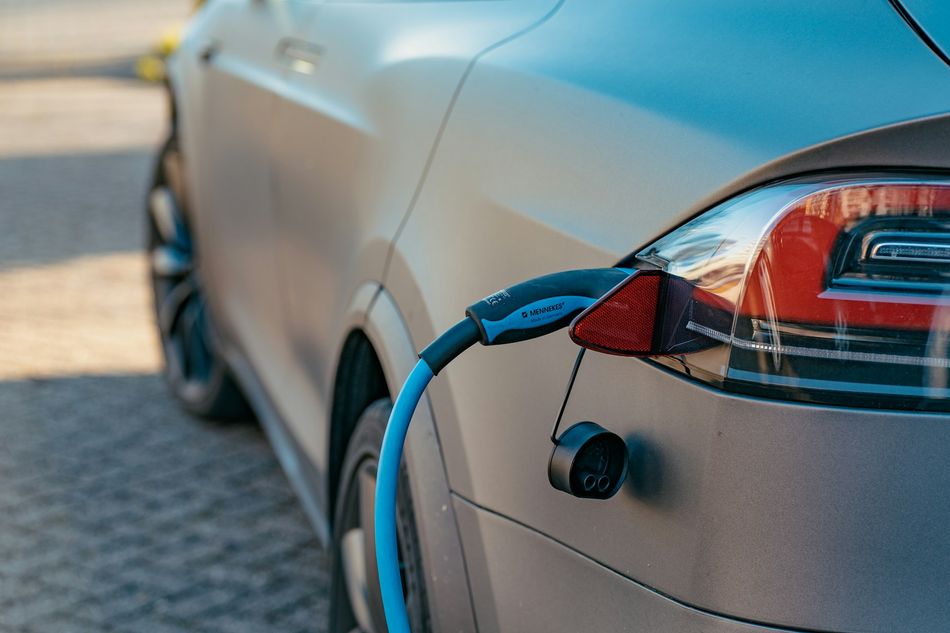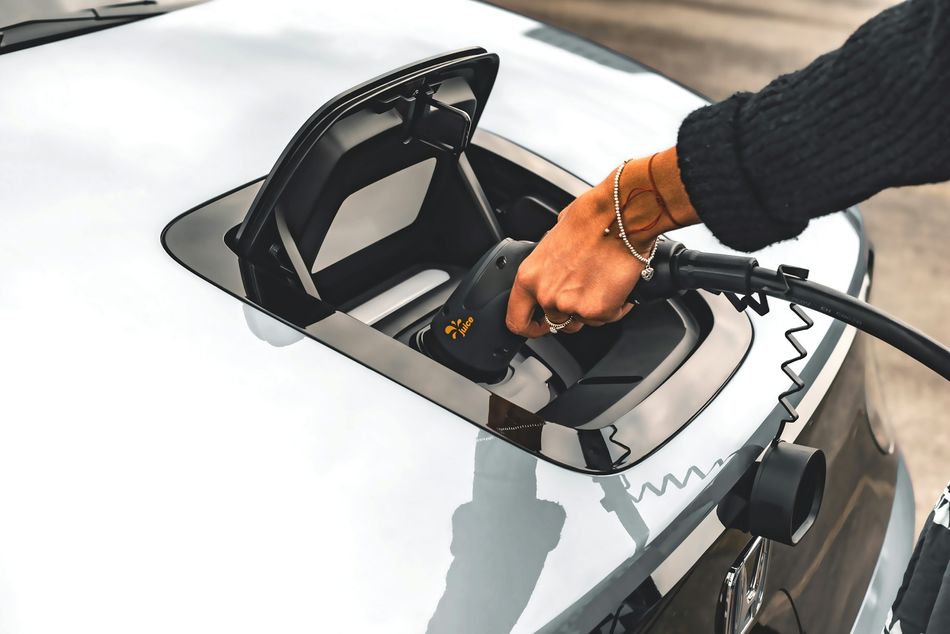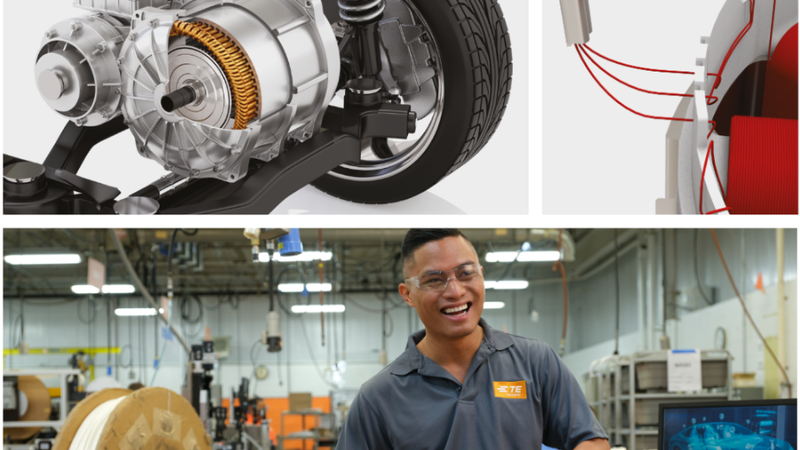Solderless Magnet Wire Solutions for Electric Vehicle Applications
Read Article #1 of 2 in the Solderless Magnet Wire Solutions Mini-Series.
This is article #1 of 2 in the Solderless Magnet Wire Solutions Mini-Series: Traditional soldering in EV motors grapples with challenges such as complexity and inconsistent joints. Solderless magnet wire solutions by TE Connectivity address these challenges by eliminating the need for soldering entirely.
Read article #2 on Solderless Magnet Wire Solutions For Electric Vehicle Air Conditioner Compressors And Electronic Parking Brake Motors.
Introduction
In the fast-paced world of electric vehicles (EVs), the efficiency and reliability of components like electric motors are crucial. Magnet wire, a key element for these motors, significantly impacts their performance and durability. Traditional soldering methods for connecting magnet wires have limitations, including complexity and inconsistent joint quality. TE Connectivity (TE) has developed innovative solderless magnet wire solutions to address these challenges. These solutions offer enhanced manufacturing efficiency and improved electric motor performance.
This is the first article in a two-part mini-series on Solderless Magnet Wire Solutions. The first article explores the challenges of traditional soldering and discusses how solderless magnet wire solutions by TE Connectivity provide more effective alternatives. The second part will expand the discussion by exploring the applications of these solutions in EVs. Case studies featuring air conditioner (AC) compressor motors and electronic parking brake (EPB) motors will highlight the real-world benefits of this innovative technology.

Soldering Magnet Wire in EV Motors
Magnet wire, or enameled wire, is a crucial component in EV motors, designed to carry electrical current that creates magnetic fields critical for motor operation. This type of wire is typically made from copper or aluminum and is coated with a thin layer of insulation to prevent electrical shorts between turns of the wire. The performance and efficiency of EV motors depend heavily on the integrity and quality of these magnet wires as they form the windings central to the motor’s function.
The magnet wire is meticulously wound into coils around a metal core in motors. These coils convert electrical energy into mechanical energy. When electric current flows through the magnet wire, it generates magnetic fields that interact with other components within the motor to produce motion. The efficiency of this energy conversion directly impacts the vehicle’s power output and operational range.
Connecting these magnet wires within the motor typically involves soldering, a method to join the wire to other metal components or terminals. Soldering involves applying heat to melt a filler metal, known as solder, which joins the wire to the component once cooled. This process requires precise temperature control to ensure the solder melts properly and forms a strong, conductive bond without damaging the wire or its insulation.
Challenges of Traditional Soldering in EV Applications
Traditional soldering techniques, while widely used in EV motor manufacturing, present a series of challenges that can compromise the efficiency and reliability of the final product. Here, we explore some main obstacles manufacturers face during the soldering process.
Insulation Removal
One of the most critical steps in preparing magnet wires for soldering is the removal of the enamel insulation. This thin layer must be stripped off without damaging the wire itself, a process requiring meticulous care and precision. Any error during this step can compromise the integrity of the wire, potentially leading to failures in motor performance.
Heat Sensitivity
Soldering introduces high temperatures that can degrade the remaining insulation around the joint area. Such heat exposure can also embrittle the copper or aluminum wire, reducing the life expectancy of the motor. The delicate balance required to apply just enough heat without causing damage is a persistent challenge in traditional soldering.
Workspace Constraints
The compact nature of electric motors often means working in tight spaces where precision is crucial. Soldering in such confined areas increases the risk of accidentally bridging connections or overheating nearby sensitive components, which can lead to short circuits or degraded component functionality.
Joint Reliability
Achieving strong, reliable solder joints is particularly challenging when dealing with thin-diameter wires that offer limited surface area for bonding. Poor joint quality can directly impact the reliability and efficiency of electric motors, influencing the overall vehicle performance.
Flux Compatibility
The use of flux in soldering magnet wires introduces another layer of complexity. Ensuring that the flux is properly matched with the specific types of magnet wires is crucial for achieving reliable adhesion and optimal conductivity. Missteps in this area can lead to weak joints and potential motor failures.
Introduction to Solderless Magnet Wire Solution
Solderless magnet wire solutions represent a significant advancement in the field of electric motor manufacturing. These technologies eliminate the need for the traditional soldering process, addressing its numerous challenges and streamlining production. But what exactly are these solutions, how do they work, and why are they so beneficial?
What Are Solderless Magnet Wire Solutions?
Solderless magnet wire solutions involve connecting wires without the need to strip insulation or use heat, which is typical of soldering. This approach uses mechanical methods or advanced materials to establish secure, reliable connections directly through the insulation, dramatically reducing the risk of damage and improving production efficiency.
 A type of solderless terminal connector mechanically secures multiple copper wires in a housing to ensure a stable and reliable electrical connection.How do they work?
A type of solderless terminal connector mechanically secures multiple copper wires in a housing to ensure a stable and reliable electrical connection.How do they work?
These connections are typically made using specialized terminals or connectors that mechanically pierce or displace the insulation on the magnet wire. This method ensures a metal-to-metal contact, creating a strong, reliable electrical connection without the inconsistencies and potential damage associated with high heat and manual insulation removal.
Why are they beneficial?
The benefits of solderless connections are manifold:
Increased Production Efficiency: Streamlines manufacturing processes by eliminating steps like insulation stripping and pre-soldering preparation.
Improved Safety: Reduces the risk of burns and other injuries associated with soldering
equipment and hot work areas.
Enhanced Reliability: Provides consistent, high-quality joints that are less susceptible
to failure due to environmental factors or aging.
Lower Cost: Decreases labor time and skill requirements, significantly reducing
production costs.
These solutions are particularly suited for medium to high-volume production environments where consistency, reliability, and efficiency are paramount. In the next section, we will look closer at TE Connectivity’s specific solderless products—AMPLIVAR, SIAMEZE, and MAG-MATE terminals—and how they address these manufacturing challenges, setting new standards in the industry.
Innovative Solderless Magnet Wire Solutions by TE Connectivity
TE Connectivity, a global leader in electrical connectivity and sensor solutions, is driving innovation in the automotive industry. Recognizing the limitations of traditional soldering methods, TE has developed a range of solderless magnet wire solutions designed to enhance performance, efficiency, and reliability in EV applications. Let’s look at how these solutions offer a faster, cleaner, and more cost-effective alternative to traditional soldering.
Each of these technologies from TE Connectivity has been designed with specific challenges of EV motor manufacturing in mind, addressing the critical needs for efficiency, reliability, and scalability. These solderless solutions help ensure that manufacturers can achieve higher quality and more durable motors, which is crucial for the demands of modern EVs.
Applications and Future Directions

Looking beyond the automotive industry, the potential applications for solderless magnet wire solutions extend into other cutting-edge fields, such as renewable energy systems and robotics. In renewable energy, these technologies can improve the efficiency and durability of generators and storage systems, pivotal in handling variable conditions and optimizing performance. In robotics, the precision and reliability of solderless connections are excellent for the small, densely packed motors required in robotic systems, where traditional soldering could limit design and functionality.
Conclusion
As we’ve explored in this article, the move towards solderless magnet wire solutions by TE Connectivity represents a significant technological advancement in manufacturing motors used in EVs. These solutions address the inherent challenges of traditional soldering, offering improved efficiency, reliability, and scalability. The impact of such technologies is not only felt within the automotive industry but is also set to influence other sectors, such as renewable energy and robotics.
This second part of our series will investigate specific case studies involving EV AC compressor motors and EPB motors. These examples will illustrate the practical benefits and real-world applications of solderless magnet wire solutions, presenting their importance in the future of EVs.
Find your Solderless Solution with TE Connectivity - Connect with us
TE Connectivity remains committed to developing and improving magnet wire solderless solutions for our manufacturing partners. Providing cost effective, sustainable connection solutions with automated assembly tools allows our customers to reduce labor costs while increasing productivity and minimizing human error. Our broad portfolio of magnet wire solutions and ability to support custom connector development let these solderless solutions fit in almost any electric motor system.
Visit www.te.com/support to chat with one of TE's Product Information Specialists.
TE, TE Connectivity, AMPLIVAR, MAG-MATE, SIAMEZE and TE connectivity (logo) are trademarks owned or licensed by the TE Connectivity plc family of companies. Other product names, logos, and company names mentioned herein may be trademarks of their respective owners. The information given herein, including drawings, illustrations and schematics which are intended for illustration purposes only, is believed to be reliable. However, TE Connectivity makes no warranties as to its accuracy or completeness and disclaims any liability in connection with its use. TE Connectivity‘s obligations shall only be as set forth in TE Connectivity‘s Standard Terms and Conditions of Sale for this product and in no case will TE Connectivity be liable for any incidental, indirect or consequential damages arising out of the sale, resale, use or misuse of the product. Users of TE Connectivity products should make their own evaluation to determine the suitability of each such product for the specific application. TE reserves the right to make any adjustments to the information contained herein at any time without notice. TE expressly disclaims all implied warranties regarding the information contained herein, including, but not limited to, any implied warranties of merchantability or fitness for a particular purpose. © 2025 TE Connectivity. All Rights Reserved.” |



